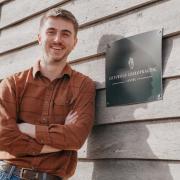I wonder if all book editors come to their role because they are nosy, or if it is just me. I’ve always suspected that a certain degree of nosiness is one of the essential qualities of someone who spends her life polishing and publishing other people’s stories in books.
One of my favourite genres is memoir – the personal histories of (relatively) ordinary people, if that can be said without offending anyone. Recently this interest was particularly piqued by two local authors, each writing about their personal memories of growing up in Cotswold villages. John Townsend had a view from Crickley Hill over 1940s Gloucester, while Ceri Vyner enjoyed rustic meadowlands near Malmesbury.
What strikes me is that these two stories are told over a similar timeline, and yet they might as well have been worlds apart.
It is safe to say that the past has always been an area of fascination for me. Prior to establishing Crumps Barn Studio in 2012, my first career was in archaeological illustration. Through my drawings, I’ve followed the order in which some distant hands knapped a Bronze Age flint arrowhead. I’ve recorded an Iron Age cremation urn, and discovered that the handprint its maker left behind in the clay is roughly the same size as mine. And I’ve even been fortunate enough to be one of the few people involved in the recording of the Cirencester Roman Cockerel before it was passed into the care of the Corinium Museum.

But I know now that it isn’t just the object that fascinates me – it’s the ephemeral sense of connection to the individual people who handled it. Their story.
In the case of the cockerel figurine, the story belongs to the hands of the people who placed it lovingly within a grave to ensure their baby’s safe passage into the afterlife.
When it comes to memoir, the story belongs to a modern day person – but for me there is that same magical sense of discovery. In many ways it is stronger because I don’t need to unravel their story from the traces that have survived the centuries. I can simply read it in their manuscript.

John Townsend is a former antiques dealer. His childhood in a tiny hamlet on the side of Crickley Hill is a story of hardship and adventure. I find it fascinating because of the way it reveals how life must have been for centuries in communities so cut off that some of the occupants would have no choice but to eke a meagre living on the rough hillside. Fallen wood was gathered for the fire, and if meat was eaten, it was commonly rabbit.
I am familiar with Cold Slad lane because of the sign on the side of the road during the steep run up to the soon-to-disappear Air Balloon Roundabout. His connection to the Air Balloon is much more substantial. As a youth, he built the steps and pillars up to the lawn area.

By contrast, Ceri Vyner’s upbringing in Little Somerford is glorious and sunny. Railway adventures involved the entire community turning out to rescue the harvest when a stray spark caused a field fire. The same gathering happily settled into a summertime picnic as soon as the rescue work was done. Ceri is also able to forge a connection to survivors from the Victorian era by being the sole person equipped to record the lives of an old farming family who were growing old while she was exploring their fields with her young brothers.
Editing and publishing these stories is the counterbalance to my previous life in archaeology. Here, I don’t need to use my imagination to reconstruct a sense of connection to a bygone era. I’m actually facilitating the individual’s wish to tell their own story. And in fact, if anything about their story still puzzles me during the editing stage, I can simply ask them and in it goes. I love it.
I mentioned my theory about nosiness being a prerequisite of publishers to the artist Alison Vickery when she visited the shop to discuss a collaborative exhibition between her artwork and one of our titles in January. She corrected me very firmly.
“You’re curious,” she said. “Not nosy. Curious.”
It sounds much more elegant when put like that. But probably not so close to the truth.
Lorna Brookes is the main editor at Cirencester publisher Crumps Barn Studio.
Two Percent Townsend by John Townsend and Let’n Went! by Ceri Vyner are both out now in paperback and ebook. www.crumpsbarn.online



























